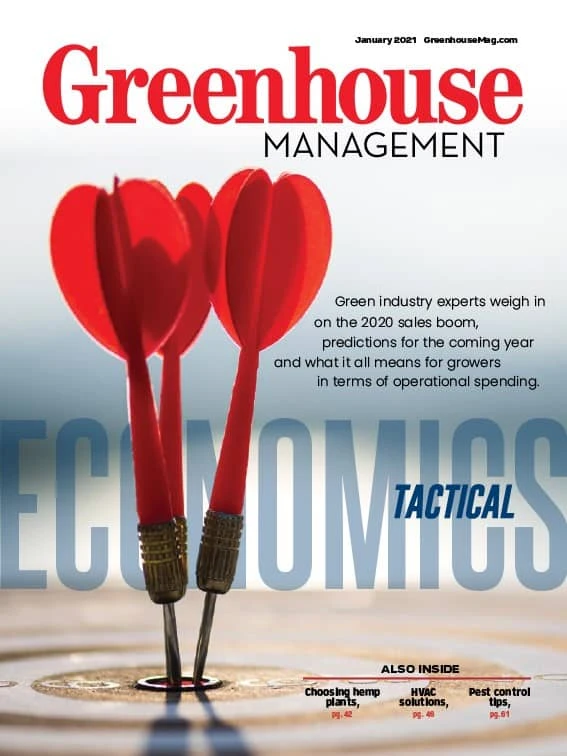
Greenhouse Management magazine: What is Pioneer Gardens’ approach to pest management?
Amanda Mattison: We do a combination of cultural practices and beneficial insects. We still use some chemicals but we’ve drastically reduced that. When I started eight years ago, they were already using beneficial insects here and getting into more sustainable practices, and that’s been something that we’ve been increasing. But we usually try to use forecasting, which is taking our production schedule and using those numbers for what we’re producing to forecast the purchase of beneficial insects. We try to be proactive and use beneficials preventatively, but we still use chemical controls and rotating modes of action as needed, just as minimally as possible. But we’re not relying on chemicals; we’re just kind of keeping them in our back pocket.
GM: What was the deciding factor for almost exclusively using beneficials and cultural practices?
AM: With chemicals, you can build up the resistance and when you go out there, you’re applying something that doesn’t give you the control that you want. Additionally, it opened up our availability for labor. We’re not constrained to an area of the greenhouse that has shut down because of a 12-hour, 24-hour REI. Our employees can go in at any time without having to worry about exposure, and it also helps with efficiency quite a bit when you’re not working around those restrictions.
GM: How do you train your staff on cultural practices and beneficial insects?
AM: Every single year at the beginning of the growing season, everybody goes through a yearly training — if they’re new, retraining, a returning employee — everyone. We go over what everything means, all the safety procedures and refamiliarize everyone with our practices and the correct way to do things. Then we give ongoing reminders and slight retraining as needed throughout the year. As far as training for scouting, we do in-house training which consists of sharing photographs and information from different resources.
GM: What’s your advice to growers who are trying to decide the best approach to pest management?
AM: I would say it all starts off with scouting. Developing a report would be my first piece of advice so that you can track what you find and so you can see the changes over time. I think sometimes you either have a false sense of security or you panic because you think you’re finding something once but actually, the trend is working in the positive direction if you were to map it out. Otherwise, I like to rely on our local extension. They have really good resources and if they don’t have the answers, they can point you towards the people that do. And the biggest thing for us has been using beneficial insects as a preventative program. You really have to develop a system and stick to it.

Explore the January 2021 Issue
Check out more from this issue and find your next story to read.
Latest from Greenhouse Management
- Anthura acquires Bromelia assets from Corn. Bak in Netherlands
- Top 10 stories for National Poinsettia Day
- Langendoen Mechanical hosts open house to showcase new greenhouse build
- Conor Foy joins EHR's national sales team
- Pantone announces its 2026 Color of the Year
- Syngenta granted federal registration for Trefinti nematicide/fungicide in ornamental market
- A legacy of influence
- HILA 2025 video highlights: John Gaydos of Proven Winners





